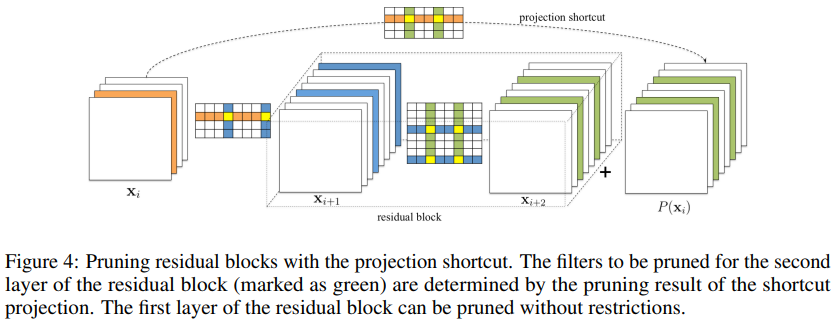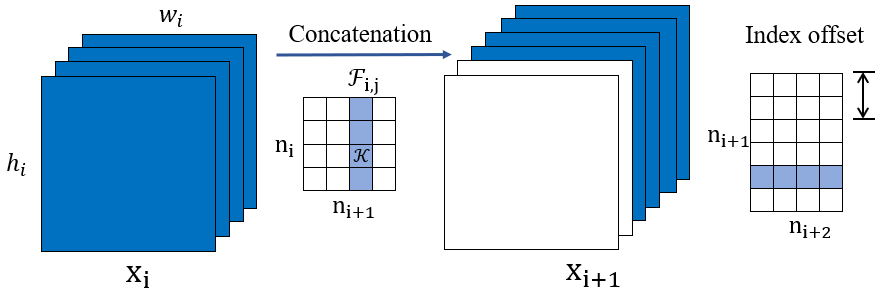- Channel pruning for CNNs (e.g. ResNet, DenseNet, Deeplab) and Transformers (e.g. Bert, contributed by @horseee)
- Graph Tracing and automatic dependency maintaining.
- Supported modules: Conv, Linear, BatchNorm, LayerNorm, Transposed Conv, PReLU, Embedding and customized modules.
- Supported operations: split, concatenation, skip connection, flatten, etc.
- Pruning strategies: Random, L1, L2, etc.
pip install torch_pruning # v0.2.7Torch-Pruning will forward your model with a fake inputs and collect layer information just like torch.jit. A dependency graph is established to describe the computational graph and layer relations. As pruning a certain layer may affect several different layers (see Quick Start), the dependecy will propogate your pruning operation to other layers automatically and provide a PruningPlan. All pruning indices will be correctly transformed if there is torch.split or torch.cat in your models.
| Dependency | Visualization | Example |
|---|---|---|
| Conv-Conv |  |
AlexNet |
| Conv-FC (Global Pooling or Flatten) | 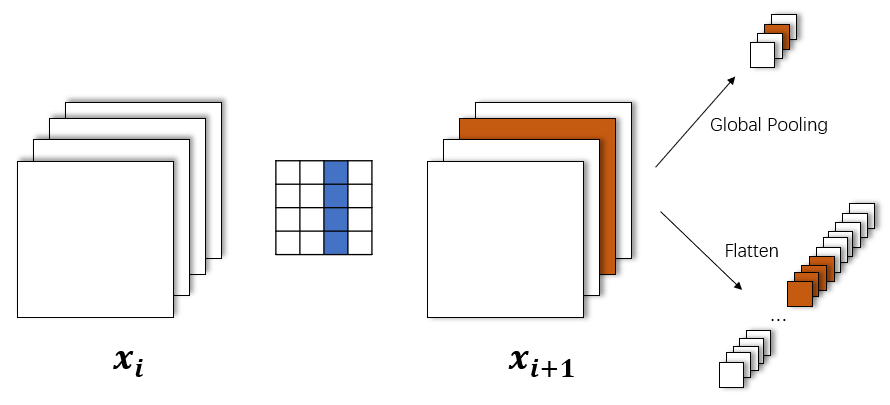 |
ResNet, VGG |
| Skip Connection | 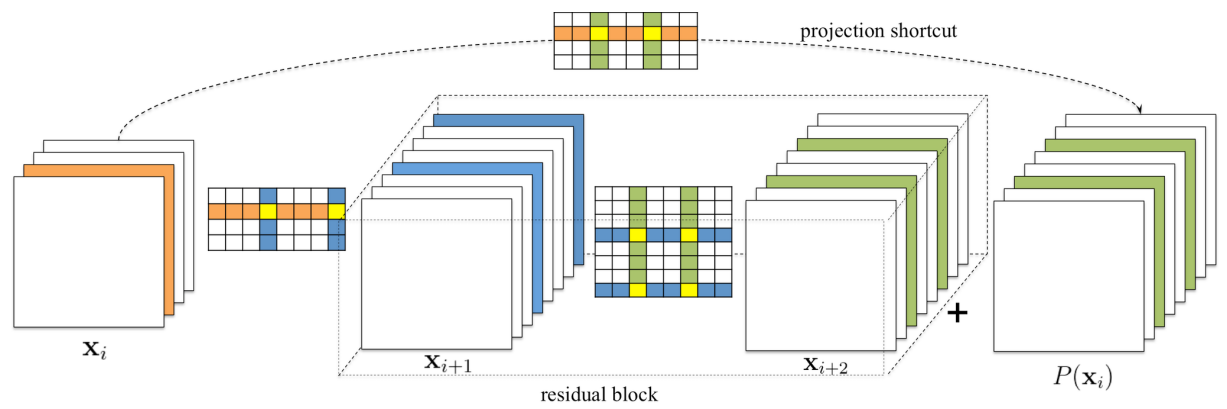 |
ResNet |
| Concatenation | 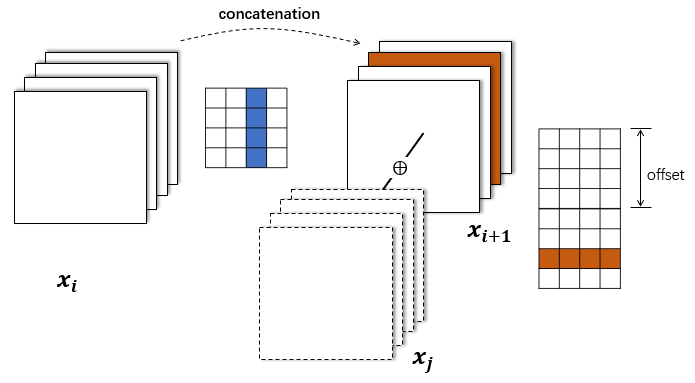 |
DenseNet, ASPP |
| Split | 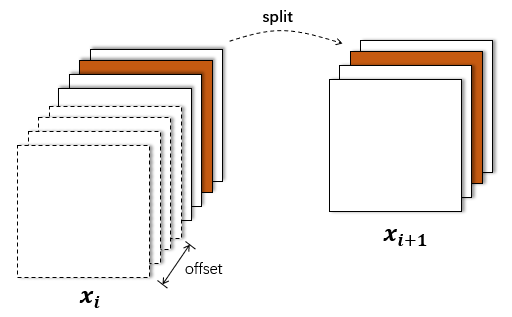 |
torch.chunk |
Known Issues:
- When groups>1, only depthwise conv is supported, i.e.
groups=in_channels=out_channels. - Customized operations will be treated as element-wise op, e.g. subclass of
torch.autograd.Function.
import torch
from torchvision.models import resnet18
import torch_pruning as tp
model = resnet18(pretrained=True).eval()
# 1. setup strategy (L1 Norm)
strategy = tp.strategy.L1Strategy() # or tp.strategy.RandomStrategy()
# 2. build layer dependency for resnet18
DG = tp.DependencyGraph()
DG.build_dependency(model, example_inputs=torch.randn(1,3,224,224))
# 3. get a pruning plan from the dependency graph.
pruning_idxs = strategy(model.conv1.weight, amount=0.4) # or manually selected pruning_idxs=[2, 6, 9, ...]
pruning_plan = DG.get_pruning_plan( model.conv1, tp.prune_conv, idxs=pruning_idxs )
print(pruning_plan)
# 4. execute this plan (prune the model)
pruning_plan.exec()Pruning the resnet.conv1 will affect several layers. Let's inspect the pruning plan (with pruning_idxs=[2, 6, 9]):
-------------
[ <DEP: prune_conv => prune_conv on conv1 (Conv2d(3, 64, kernel_size=(7, 7), stride=(2, 2), padding=(3, 3), bias=False))>, Index=[2, 6, 9], NumPruned=441]
[ <DEP: prune_conv => prune_batchnorm on bn1 (BatchNorm2d(64, eps=1e-05, momentum=0.1, affine=True, track_running_stats=True))>, Index=[2, 6, 9], NumPruned=6]
[ <DEP: prune_batchnorm => _prune_elementwise_op on _ElementWiseOp()>, Index=[2, 6, 9], NumPruned=0]
[ <DEP: _prune_elementwise_op => _prune_elementwise_op on _ElementWiseOp()>, Index=[2, 6, 9], NumPruned=0]
[ <DEP: _prune_elementwise_op => prune_related_conv on layer1.0.conv1 (Conv2d(64, 64, kernel_size=(3, 3), stride=(1, 1), padding=(1, 1), bias=False))>, Index=[2, 6, 9], NumPruned=1728]
[ <DEP: _prune_elementwise_op => _prune_elementwise_op on _ElementWiseOp()>, Index=[2, 6, 9], NumPruned=0]
[ <DEP: _prune_elementwise_op => prune_batchnorm on layer1.0.bn2 (BatchNorm2d(64, eps=1e-05, momentum=0.1, affine=True, track_running_stats=True))>, Index=[2, 6, 9], NumPruned=6]
[ <DEP: prune_batchnorm => prune_conv on layer1.0.conv2 (Conv2d(64, 64, kernel_size=(3, 3), stride=(1, 1), padding=(1, 1), bias=False))>, Index=[2, 6, 9], NumPruned=1728]
[ <DEP: _prune_elementwise_op => _prune_elementwise_op on _ElementWiseOp()>, Index=[2, 6, 9], NumPruned=0]
[ <DEP: _prune_elementwise_op => prune_related_conv on layer1.1.conv1 (Conv2d(64, 64, kernel_size=(3, 3), stride=(1, 1), padding=(1, 1), bias=False))>, Index=[2, 6, 9], NumPruned=1728]
[ <DEP: _prune_elementwise_op => _prune_elementwise_op on _ElementWiseOp()>, Index=[2, 6, 9], NumPruned=0]
[ <DEP: _prune_elementwise_op => prune_batchnorm on layer1.1.bn2 (BatchNorm2d(64, eps=1e-05, momentum=0.1, affine=True, track_running_stats=True))>, Index=[2, 6, 9], NumPruned=6]
[ <DEP: prune_batchnorm => prune_conv on layer1.1.conv2 (Conv2d(64, 64, kernel_size=(3, 3), stride=(1, 1), padding=(1, 1), bias=False))>, Index=[2, 6, 9], NumPruned=1728]
[ <DEP: _prune_elementwise_op => _prune_elementwise_op on _ElementWiseOp()>, Index=[2, 6, 9], NumPruned=0]
[ <DEP: _prune_elementwise_op => prune_related_conv on layer2.0.conv1 (Conv2d(64, 128, kernel_size=(3, 3), stride=(2, 2), padding=(1, 1), bias=False))>, Index=[2, 6, 9], NumPruned=3456]
[ <DEP: _prune_elementwise_op => prune_related_conv on layer2.0.downsample.0 (Conv2d(64, 128, kernel_size=(1, 1), stride=(2, 2), bias=False))>, Index=[2, 6, 9], NumPruned=384]
11211 parameters will be pruned
-------------
Tip: please remember to save the whole model object (weights+architecture) rather than model weights only:
# save a pruned model
# torch.save(model.state_dict(), 'model.pth') # weights only
torch.save(model, 'model.pth') # obj (arch + weights), recommended.
# load a pruned model
model = torch.load('model.pth') # no load_state_dictIn absence of DependencyGraph, we have to manually handle the broken dependencies layer by layer.
tp.prune_conv( model.conv1, idxs=[2,6,9] )
# fix the broken dependencies manually
tp.prune_batchnorm( model.bn1, idxs=[2,6,9] )
tp.prune_related_conv( model.layer2[0].conv1, idxs=[2,6,9] )
...Please refer to examples/customized_layer.py.
You can round the channels by passing a round_to parameter to strategy. For example, the following script will round the number of channels to 16xN (e.g., 16, 32, 48, 64).
strategy = tp.strategy.L1Strategy()
pruning_idxs = strategy(model.conv1.weight, amount=0.2, round_to=16)Please refer to VainF#38 for more details.
cd examples
python prune_resnet18_cifar10.py --mode train # 11.1M, Acc=0.9248python prune_resnet18_cifar10.py --mode prune --round 1 --total_epochs 30 --step_size 20 # 4.5M, Acc=0.9229
python prune_resnet18_cifar10.py --mode prune --round 2 --total_epochs 30 --step_size 20 # 1.9M, Acc=0.9207
python prune_resnet18_cifar10.py --mode prune --round 3 --total_epochs 30 --step_size 20 # 0.8M, Acc=0.9176
python prune_resnet18_cifar10.py --mode prune --round 4 --total_epochs 30 --step_size 20 # 0.4M, Acc=0.9102
python prune_resnet18_cifar10.py --mode prune --round 5 --total_epochs 30 --step_size 20 # 0.2M, Acc=0.9011
...During structured pruning, we need to maintain the channel consistency between different layers.
the layer dependency becomes much more complicated when the model contains skip connections or concatenations.
See paper Pruning Filters for Efficient ConvNets for more details.


